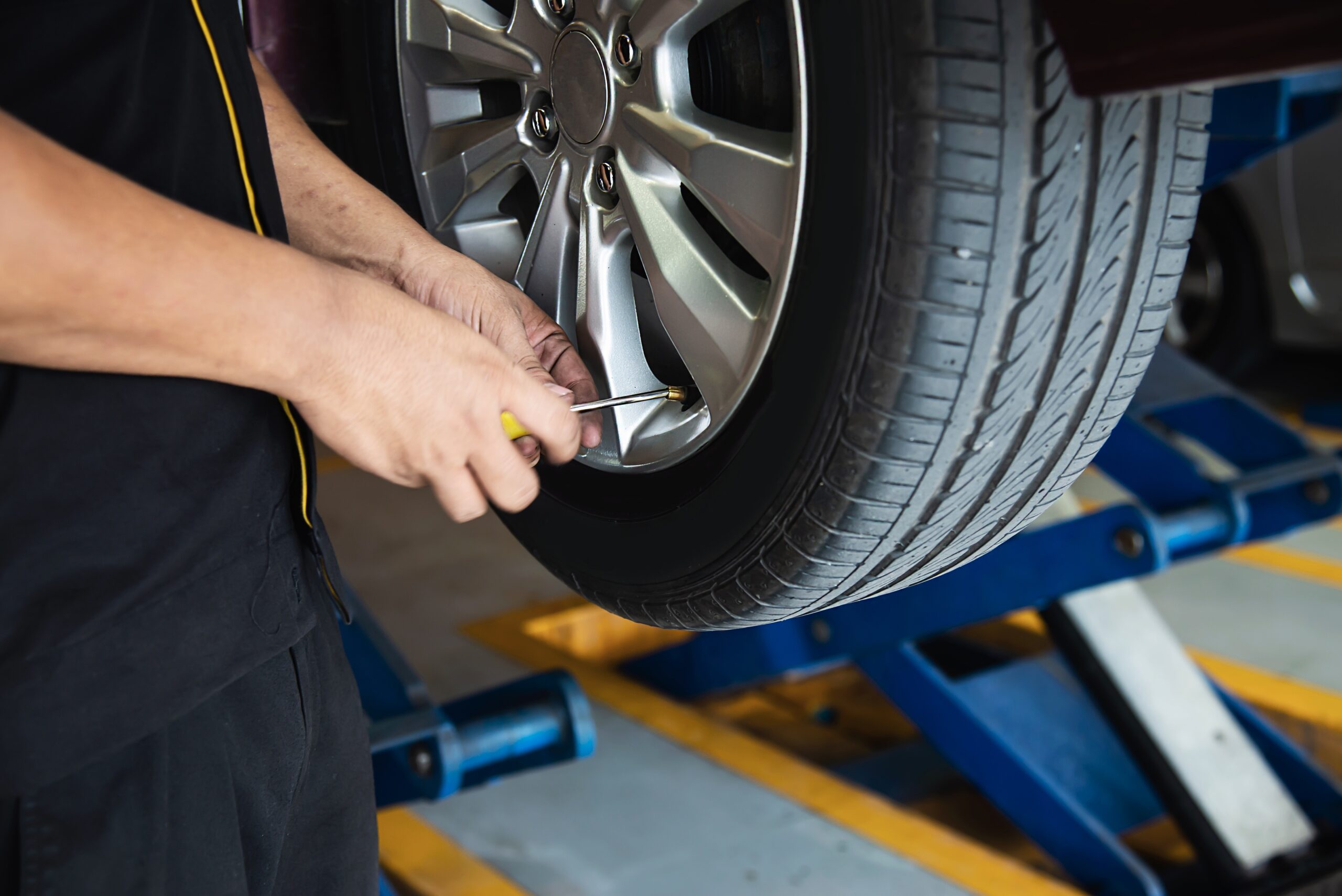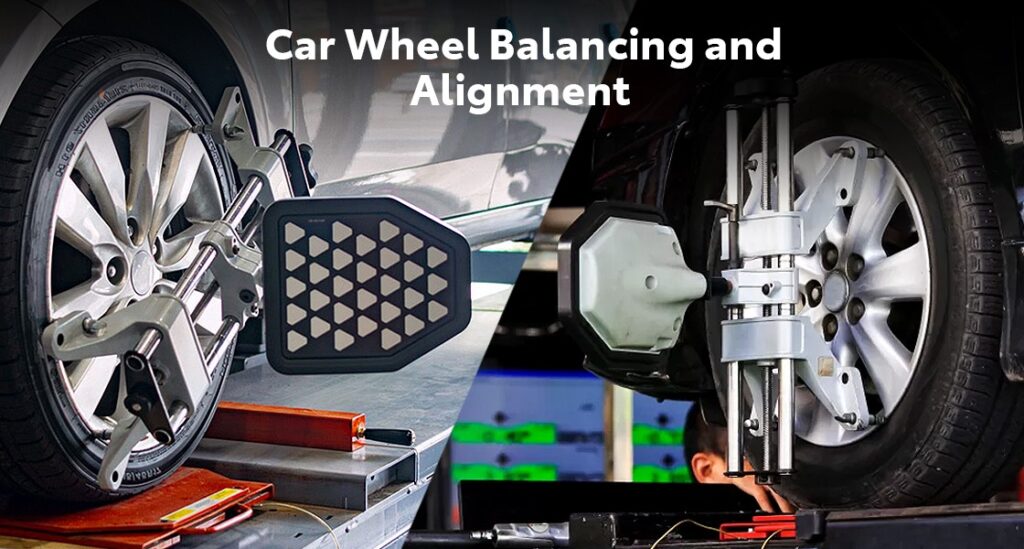Car wheel balancing and alignment services are important for the smooth functioning of your vehicle.
Maintaining your car’s tyres is one of the most important aspects of smooth and efficient driving. Tyres are the only part of the car that directly touches the road, which makes their condition vital for performance, safety, and overall driving comfort.
Car wheel balancing and alignment services play a direct role in extending the life of your tyres, reducing repair costs, and improving fuel efficiency.

Find below the importance of car wheel balancing and alignment.
Table of Contents
ToggleWhat is Wheel Balancing?
Wheel balancing refers to the process of equalizing the weight distribution around a tyre and wheel assembly. Over time, tyres and wheels may develop slight imbalances due to uneven wear, manufacturing variations, or impacts such as hitting potholes.
- During wheel balancing, technicians use specialized machines to detect weight imbalances.
- Small counterweights are then attached to the wheel rim to correct the imbalance.
- The process ensures that the wheels rotate smoothly without causing vibrations or uneven stress.
Key signs your car needs wheel balancing:
- Vibration in the steering wheel or floorboard while driving.
- Uneven or patchy tyre wear.
- Reduced driving comfort and control.
What is Wheel Alignment?
Wheel alignment refers to adjusting the angles of the wheels so that they are set to the manufacturer’s recommended position. Proper alignment ensures that all four wheels point in the correct direction and make even contact with the road.
Alignment is measured in three key angles:
- Camber – the inward or outward tilt of the tyre when viewed from the front.
- Caster – the tilt of the steering axis when viewed from the side.
- Toe – the inward or outward direction the tyres point when viewed from above.
Signs your car needs wheel alignment:
- The vehicle pulls to one side when driving straight.
- Uneven tyre wear.
- Crooked steering wheel while driving straight.
- Poor handling and reduced fuel efficiency.
How Wheel Balancing Enhances Tyre Life?
Tyres tend to lose balance as they wear down. However, driving with imbalanced wheels can lead to premature tyre damage. Find below how wheel balancing helps extend tyre life:
- Prevents uneven wear: Balanced wheels distribute the load equally, reducing stress on specific tyre areas.
- Reduces vibrations: Vibrations caused by imbalance can weaken tyre sidewalls and cause patchy wear.
- Improves tread longevity: By ensuring uniform rotation, balancing helps maintain even tread wear, extending the lifespan of tyres.
- Protects suspension and bearings: Less vibration means less strain on suspension parts and wheel bearings, indirectly protecting tyre condition.
How Wheel Alignment Enhances Tyre Life?
Proper alignment is necessary in extending tyre life because it directly affects how tyres make contact with the road.
- Prevents rapid tread wear: Misaligned wheels often drag instead of rolling freely, leading to excessive wear on certain areas.
- Improves contact patch: Alignment ensures that tyres maintain maximum road contact, allowing even wear across the tread surface.
- Protects tyres from side damage: Incorrect camber or toe settings can cause the tyre’s edges to wear out prematurely.
- Reduces rolling resistance: Proper alignment lowers road friction, reducing tyre heat buildup and extending life.
What are the Risks of Skipping Car Wheel Balancing and Alignment?
Ignoring these services can shorten tyre lifespan significantly and lead to costly repairs. Some of the risks include:
- Premature tyre replacement: Uneven wear patterns mean tyres need replacement sooner.
- Reduced fuel efficiency: Misaligned tyres increase rolling resistance, consuming more fuel.
- Unsafe driving: Poor grip, reduced handling, and longer braking distances increase accident risks.
- Damage to suspension components: Vibrations and uneven forces can wear out shocks, struts, and steering systems.
- Higher repair costs: Neglecting small balancing/alignment adjustments can lead to expensive tyre and suspension replacements.
When Should You Get Wheel Balancing and Alignment Done?
Car wheel balancing and alignment should be carried out regularly as part of preventive maintenance. These services are generally recommended at:
- Every 10,000–12,000 km (or as per manufacturer recommendation).
- After replacing tyres or wheels.
- After hitting potholes, curbs, or speed bumps at high speed.
- If you notice vibration, uneven wear, or steering issues.
- During routine servicing, alignment and balancing checks are often part of scheduled service intervals.
Benefits Beyond Extending Tyre Life
Apart from extending tyre life, car wheel balancing and alignment offer additional benefits:
- Improved fuel economy: Proper alignment reduces unnecessary drag, saving fuel.
- Better handling and comfort: Balanced and aligned wheels improve steering response and stability.
- Enhanced safety: Even tyre contact ensures better grip, shorter braking distance, and reduced chances of skidding.
- Cost savings: By extending tyre life and reducing suspension wear, you avoid frequent replacements and costly repairs.
FAQs on Wheel Balancing and Alignment
Q1. How often should I balance and align my wheels?
Ideally, every 10,000–12,000 km or twice a year. However, you should also do it after tyre changes, accidents, or when you notice uneven wear or handling issues.
Q2. Can car wheel alignment and balancing be done together?
Yes, most service centers recommend doing both together since they complement each other for optimal performance and tyre longevity.
Q3. What happens if I don’t balance my car wheels?
Unbalanced wheels cause vibrations, uneven tyre wear, and additional stress on suspension components, ultimately reducing tyre life.
Q4. Does wheel alignment affect mileage?
Yes. Misaligned wheels create drag, forcing the engine to work harder and consume more fuel. Proper alignment improves fuel efficiency.
Q5. Can I drive with unbalanced or misaligned wheels?
While the car may still move, prolonged driving with imbalances or misalignment will cause faster tyre wear, unsafe handling, and increased repair costs.
Q6. How do I know if my tyres are wearing unevenly?
Look for signs like bald spots, worn edges, feathered tread, or one tyre wearing faster than the others. These usually indicate balancing or alignment issues.
Q7. Is wheel alignment necessary after tyre rotation?
Not always, but it’s a good practice to check alignment when rotating tyres to ensure even wear across all wheels.
Wheel balancing and alignment are essential for maintaining your car’s tyres, ensuring safety, and maximizing cost savings. By keeping your wheels balanced, you reduce vibrations and uneven tread wear, while alignment ensures your tyres make proper contact with the road. Together, they significantly enhance tyre life, improve fuel efficiency, and provide a smoother, safer driving experience.
Auto Car Repair – Multi-Brand Car Service
Looking for a reliable car service center in Delhi NCR?
Auto Car Repair is committed to providing high-quality car repairs and services across its multiple workshops in Delhi NCR. Their certified technicians use the latest technology and tools to diagnose and repair various car issues.
Book your car service at Auto Car Repair today!
Visit Auto Car Repair Locations
Moti Nagar: 60 N G Road, Rama Rd, Moti Nagar, New Delhi, Delhi 110015
Okhla: G7JF+F87, Pocket W, Okhla Phase II, Okhla Industrial Estate, New Delhi, Delhi 110020
Noida: H-142, near Ananda Corporate Office, H Block, Sector 63, Noida, Uttar Pradesh 201301

